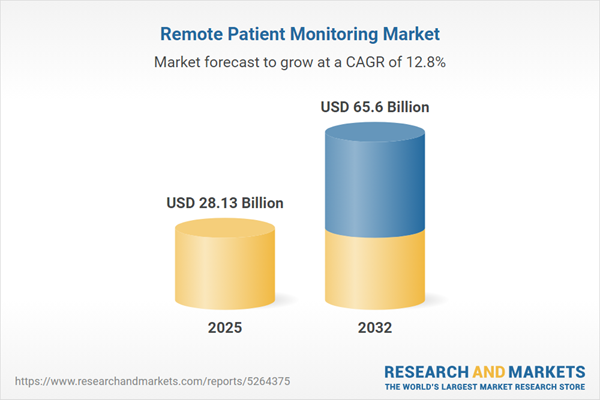Speak directly to the analyst to clarify any post sales queries you may have.
Remote patient monitoring (RPM) is transforming healthcare operations by equipping organizations with digital strategies that enhance care coordination, improve patient outcomes, and streamline resource management. As senior decision-makers seek to drive sustainable growth and regulatory compliance, RPM provides a critical platform for adapting to modern healthcare challenges while enabling scalable and patient-centric operations.
Market Snapshot: Key Remote Patient Monitoring Market Trends and Growth
The global remote patient monitoring market is experiencing significant growth, propelled by widespread healthcare digitization and the integration of advanced connectivity solutions. Digital transformation initiatives help organizations expand patient engagement, optimize clinical workflows, and manage chronic disease populations more effectively. The market is evolving through integrated digital processes and adaptive compliance solutions that enable quality improvement. Evolving regulations, changing demographic profiles, and updated care delivery models are driving providers to adopt innovative RPM technologies that enhance connected experiences for both patients and care teams.
Scope & Segmentation
This executive report provides actionable analysis of the remote patient monitoring landscape, assisting leaders in evaluating, selecting, and deploying scalable RPM technologies. The market’s broad scope reflects its ability to align with diverse healthcare operations and clinical priorities, paving the way for flexible adoption across global settings.
- Product Types: Fixed devices, portable monitors, wearables, professional services, and integrated software platforms facilitate automated workflows and improve care efficiency.
- Delivery Modes: Cloud-based and on-premise RPM offerings address various compliance requirements, support seamless interoperability, and allow organizations to flexibly scale deployments in response to evolving business needs.
- Monitoring Modes: Continuous, intermittent, and event-driven solutions enable tailored patient management and support adaptive care models in different clinical scenarios.
- End Users: Ambulatory care centers, home health providers, hospitals, specialty clinics, assisted and independent living facilities use RPM to match operational models with distinct patient groups.
- Applications: Cardiac, diabetes, hypertension, respiratory, pediatric, geriatric, and post-surgical use cases demonstrate RPM’s versatility in meeting specialized clinical and patient demands.
- Regional Coverage: Americas, Europe, Middle East and Africa, and Asia-Pacific regions are analyzed for specific regulatory, reimbursement, and operational factors that shape local adoption strategies and market entry priorities.
- Leading Companies: Koninklijke Philips N.V., Medtronic plc, GE HealthCare, Abbott Laboratories, Boston Scientific Corporation, ResMed Inc., Masimo Corporation, Dexcom, Inc., iRhythm Technologies, Inc., Accuhealth Technologies LLC, along with emerging technology providers, set the competitive landscape.
Remote Patient Monitoring Market: Key Takeaways for Executives
- The integration of artificial intelligence and machine learning within RPM enhances predictive analytics, empowering faster clinical decision-making and supporting value-based care initiatives in dynamic healthcare environments.
- Evolving procurement and reimbursement practices require robust frameworks, helping healthcare enterprises adapt to shifting policy and regulatory demands while strengthening operational resilience.
- Advanced mobile networks and wireless connectivity are enabling organizations to integrate RPM systems into diverse IT landscapes, ensuring technology compatibility with existing health infrastructures.
- Data security and platform interoperability have become central to regulatory compliance, protecting sensitive patient information and reinforcing trust in digital health strategies.
- Open APIs and strategic cross-sector partnerships are creating new opportunities for service delivery enhancement and rapid market adaptation, fostering greater organizational flexibility.
- RPM applications now extend to pediatric and rehabilitative care settings, highlighting the technology’s ability to support wide-ranging, complex patient populations and broaden the scope of remote care services.
Tariff Impact on Remote Patient Monitoring Supply Chain
Recent changes in U.S. tariff policies have influenced RPM supply chain dynamics, driving organizations to prioritize localized manufacturing and modular device design. These adjustments enable improved quality oversight and quicker responses to evolving regulatory requirements, supporting business continuity and sustainability amid shifting trade policies.
Methodology & Data Sources
This report synthesizes extensive secondary research, direct input from healthcare executives, and feedback from leading technology vendors. Legal and regulatory intelligence is incorporated to support evidence-based organizational planning and technology investment decisions.
Why This Report Matters
- Provides benchmarks for RPM integration and compliance, equipping decision-makers to enhance processes in alignment with industry standards.
- Informs technology and supply chain partnerships, supporting robust and efficient healthcare operations.
- Delivers current insights to help executives adjust investment strategies as care needs and healthcare markets evolve.
Conclusion
Remote patient monitoring delivers the digital foundation healthcare organizations need to achieve operational agility and meet the demands of fast-changing health markets. Senior leaders can act on these insights to accelerate technology adoption and ensure long-term organizational readiness.
Additional Product Information:
- Purchase of this report includes 1 year online access with quarterly updates.
- This report can be updated on request. Please contact our Customer Experience team using the Ask a Question widget on our website.
Table of Contents
3. Executive Summary
4. Market Overview
7. Cumulative Impact of Artificial Intelligence 2025
Companies Mentioned
The companies profiled in this Remote Patient Monitoring market report include:- Koninklijke Philips N.V.
- Medtronic plc
- GE HealthCare
- Abbott Laboratories
- Boston Scientific Corporation
- ResMed Inc.
- Masimo Corporation
- Dexcom, Inc.
- iRhythm Technologies, Inc.
- Accuhealth Technologies LLC
- ACME Consultin
- Athelas, Inc.
- Cadence Health, Inc.
- CareSimple Inc.
- CCN Health
- Clinitouch
- Cosinuss GmbH
- eDevice
- Flatworld Solutions Inc.
- Health Recovery Solutions
- Humworld Inc.
- InfoBionic, Inc.
- Modivcare
- Oracle Corporation
- Siemens Healthcare AG
Table Information
| Report Attribute | Details |
|---|---|
| No. of Pages | 189 |
| Published | October 2025 |
| Forecast Period | 2025 - 2032 |
| Estimated Market Value ( USD | $ 28.13 Billion |
| Forecasted Market Value ( USD | $ 65.6 Billion |
| Compound Annual Growth Rate | 12.7% |
| Regions Covered | Global |
| No. of Companies Mentioned | 26 |









